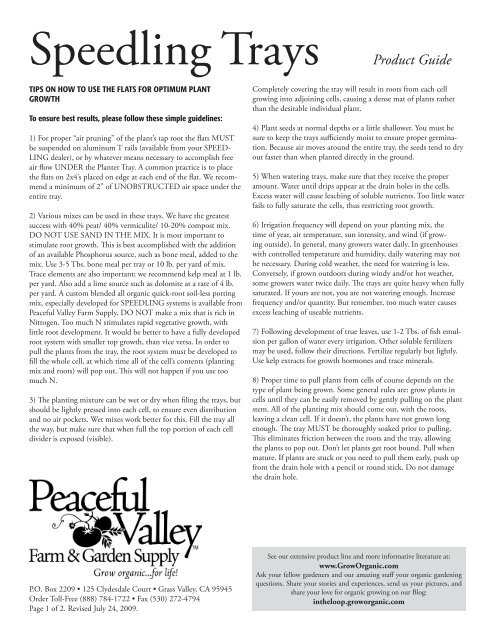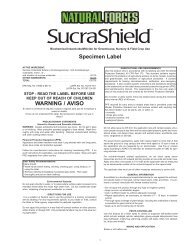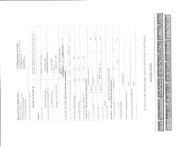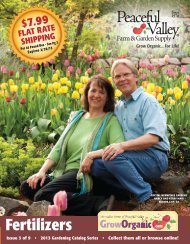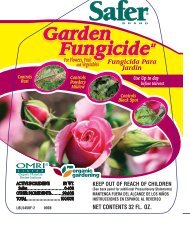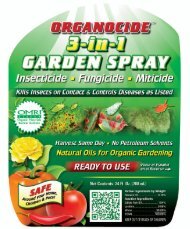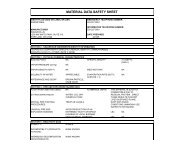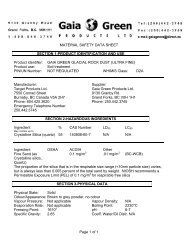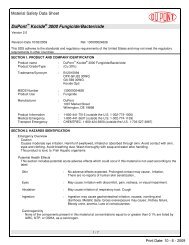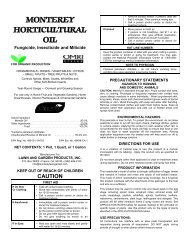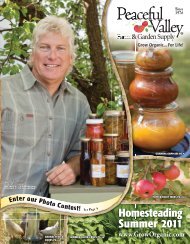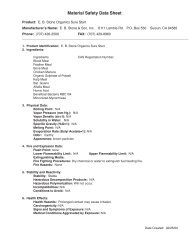Speedling Trays Product Guide - Peaceful Valley Farm Supply
Speedling Trays Product Guide - Peaceful Valley Farm Supply
Speedling Trays Product Guide - Peaceful Valley Farm Supply
You also want an ePaper? Increase the reach of your titles
YUMPU automatically turns print PDFs into web optimized ePapers that Google loves.
<strong>Speedling</strong> <strong>Trays</strong><strong>Product</strong> <strong>Guide</strong>TIPS ON HOW TO USE THE FLATS FOR OPTIMUM PLANTGROWTHTo ensure best results, please follow these simple guidelines:1) For proper “air pruning” of the plant’s tap root the flats MUSTbe suspended on aluminum T rails (available from your SPEED-LING dealer), or by whatever means necessary to accomplish freeair flow UNDER the Planter Tray. A common practice is to placethe flats on 2x4’s placed on edge at each end of the flat. We recommenda minimum of 2” of UNOBSTRUCTED air space under theentire tray.2) Various mixes can be used in these trays. We have the greatestsuccess with 40% peat/ 40% vermiculite/ 10-20% compost mix.DO NOT USE SAND IN THE MIX. It is most important tostimulate root growth. This is best accomplished with the additionof an available Phosphorus source, such as bone meal, added to themix. Use 3-5 Tbs. bone meal per tray or 10 lb. per yard of mix.Trace elements are also important; we recommend kelp meal at 1 lb.per yard. Also add a lime source such as dolomite at a rate of 4 lb.per yard. A custom blended all organic quick-root soil-less pottingmix, especially developed for SPEEDLING systems is available from<strong>Peaceful</strong> <strong>Valley</strong> <strong>Farm</strong> <strong>Supply</strong>. DO NOT make a mix that is rich inNitrogen. Too much N stimulates rapid vegetative growth, withlittle root development. It would be better to have a fully developedroot system with smaller top growth, than vice versa. In order topull the plants from the tray, the root system must be developed tofill the whole cell, at which time all of the cell’s contents (plantingmix and roots) will pop out. This will not happen if you use toomuch N.3) The planting mixture can be wet or dry when filing the trays, butshould be lightly pressed into each cell, to ensure even distributionand no air pockets. Wet mixes work better for this. Fill the tray allthe way, but make sure that when full the top portion of each celldivider is exposed (visible).Completely covering the tray will result in roots from each cellgrowing into adjoining cells, causing a dense mat of plants ratherthan the desirable individual plant.4) Plant seeds at normal depths or a little shallower. You must besure to keep the trays sufficiently moist to ensure proper germination.Because air moves around the entire tray, the seeds tend to dryout faster than when planted directly in the ground.5) When watering trays, make sure that they receive the properamount. Water until drips appear at the drain holes in the cells.Excess water will cause leaching of soluble nutrients. Too little waterfails to fully saturate the cells, thus restricting root growth.6) Irrigation frequency will depend on your planting mix, thetime of year, air temperature, sun intensity, and wind (if growingoutside). In general, many growers water daily. In greenhouseswith controlled temperature and humidity, daily watering may notbe necessary. During cold weather, the need for watering is less.Conversely, if grown outdoors during windy and/or hot weather,some growers water twice daily. The trays are quite heavy when fullysaturated. If yours are not, you are not watering enough. Increasefrequency and/or quantity. But remember, too much water causesexcess leaching of useable nutrients.7) Following development of true leaves, use 1-2 Tbs. of fish emulsionper gallon of water every irrigation. Other soluble fertilizersmay be used, follow their directions. Fertilize regularly but lightly.Use kelp extracts for growth hormones and trace minerals.8) Proper time to pull plants from cells of course depends on thetype of plant being grown. Some general rules are: grow plants incells until they can be easily removed by gently pulling on the plantstem. All of the planting mix should come out, with the roots,leaving a clean cell. If it doesn’t, the plants have not grown longenough. The tray MUST be thoroughly soaked prior to pulling.This eliminates friction between the roots and the tray, allowingthe plants to pop out. Don’t let plants get root bound. Pull whenmature. If plants are stuck or you need to pull them early, push upfrom the drain hole with a pencil or round stick. Do not damagethe drain hole.P.O. Box 2209 • 125 Clydesdale Court • Grass <strong>Valley</strong>, CA 95945Order Toll-Free (888) 784-1722 • Fax (530) 272-4794Page 1 of 2. Revised July 24, 2009.See our extensive product line and more informative literature at:www.GrowOrganic.comAsk your fellow gardeners and our amazing staff your organic gardeningquestions. Share your stories and experiences, send us your pictures, andshare your love for organic growing on our Blog:intheloop.groworganic.com
9) Virtually every type of vegetable, herb or flower can be grown usingthe SPEEDLING method. The exceptions are carrots and plantsgrown from tubers such as potatoes, or those grown from bulbs suchas garlic, gladiolus, etc. Nearly all commercial growers using thissystem grow all of their plants in the one inch cells (200 cells pertray). Many growers have good success with the 1 ¼” and 2” cells,especially for plants which normally stay in the cells for a fairly longperiod of time such as tomatoes, peppers and eggplants. 2” cellsare exceptionally good for melons, cukes, squashes, etc. 3” cells aresuitable for any extremely large transplants. It should be emphasizedthat all tray sizes will do an excellent job of growing any of these orother plants. Bigger plants will be obtained from the larger size cells;quicker time to transplanting and greater use of space with the smallcells.10) Good success has been obtained by planting root crops inclumps. Plant crops such as beets, turnips, leeks, parsnips, scallions,bulb onions, chives, etc. by putting 3-5 seeds in each cell (1” size)and thinning if necessary to three plants. These can then be transplantedout to grow in small clusters with excellent success. Greenonions can be planted as thick as 7-9 seeds and left as is to grow ina clump. Other growers are having good success raising parsley andspinach in clumps by planting 2-3 seeds per cell. Experiment—please let us know your results.11) For maximum service and use, caution should be used to avoidphysical damage to trays. Many growers get 25-30 uses out of eachtray with proper care. The tray should be protected from excessiveheat and sunlight when not in use. If you have disease problems, thetrays can be sterilized with hot water, or steam, or use a 2% chlorinebleach an water solution. Do not place in boiling water. Do not getgas or other petroleum solvents on the trays.You have purchased a state of the art transplanting system. Followthese instructions and you will grow the healthiest, most vigorousplants possible.TO BE ECONOMICAL, AGRICULTURE MUST BE ECOLOGICALP.O. Box 2209 • 125 Clydesdale Court • Grass <strong>Valley</strong>, CA 95945Order Toll-Free (888) 784-1722 • Fax (530) 272-4794Page 2 of 2. Revised July 24, 2009.


